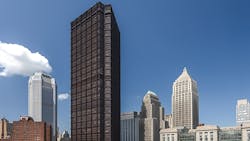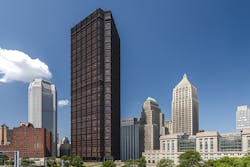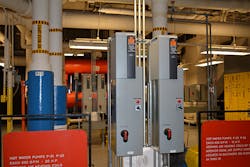In 1971, United States Steel Corp. completed construction of its world headquarters in downtown Pittsburgh. Currently known as U.S. Steel Tower, the building stands 64 stories and 841 ft, which makes it not only the tallest building in Pittsburgh, but the tallest building between Chicago and Philadelphia.
“We’re moving a lot of water and air up, down, and around (each story contains an acre of floor space) this building,” Gary Sechler, engineering manager for Winthrop Management, the building’s property manager, said. “Water is supplied by two redundant water mains. In addition, there are four redundant 100-hp water pumps in the building. Each one can serve the entire building, if needed. There are also two boilers on the 64th floor and two centrifugal chillers on the 63rd floor to provide redundant heating and cooling. So, there is a lot of pumping needed for domestic-water circulation and for the chilled-water loops, all of which consume a lot of energy.”
Ahead of its time during the 1970s, the building had fallen behind by the turn of the millennium with mechanical equipment installed when kilowatts cost pennies and oil was $3 a barrel. It was then that Winthrop Management began a series of retrofits using Danfoss VLT variable-frequency drives (VFDs), which have resulted in more than $1 million in energy savings.
“We have been applying Danfoss VLT drives in various retrofit projects for nearly 15 years,” Sechler said. “After every retrofit-project phase, we’ve found the energy savings on pump motors and fans have been outstanding. So, we would embark on another phase. As it stands now, we’ve installed more than 150 VLT drives—with more to come.”
Series of Retrofits
The first drive retrofit project took place in 2000, when VLT drives were applied to four 100-hp pump motors responsible for the building’s domestic-water supply.
“The old drives were two-step drives like they used in steel mills back in the day,” Jim Rice, owner of M&R Affiliates, a Danfoss sales representative, said. “They weren’t true variable-frequency drives. We replaced them with four Danfoss VLT model FC102 drives that delivered 100 hp at 460 v and provided a true soft start.”
The soft start, Sechler said, eliminated a lot of wear and tear on the motors and saved energy.
“We’re talking big motors to pump water to a 300-gal. cushioning tank on the 64th floor,” Sechler said. “From there, gravity feeds the water down fountains, sinks, and toilets on the floors below. Only two of the four pumps run at any given time in a lead-lag sequence that alternates weekly. But the old motor-speed controls were obsolete, and parts were no longer available. I don’t have a record of energy savings from that time, but I do know, with the soft start on VLT drives, pump-motor rebuilds have been zero.”
The next retrofit opportunity presented itself after the Commonwealth of Pennsylvania passed legislation (Act 129 of 2008) requiring electricity distribution companies to reduce electricity consumption and peak demand, and Duquesne Light Co. provided a rebate program for businesses that replace old-style motor-speed throttling technology with VFDs.
“We jumped on this program,” Sechler said. “We knew what VLT drives did for our house water pumps. So, in 2010, we looked at what they could do for our large 200- to 250-hp fan motors. These fans circulate conditioned air in large office areas at a given static pressure to satisfy the temperature setpoint. We ended up applying about 40 more FC102 drives for motors ranging from 30 hp to 250 hp.
“We were absolutely delighted with the energy savings,” Sechler continued, “because the drives cut electricity costs by $535,000 annually. And along with those savings, we got rebates that produced a one-year payback. So, naturally, we kept looking for more places to apply drives.”
In 2011, VLT drives were applied to pump motors for the chilled-water and pre-heat water loops.
“These pump motors are considerably smaller than those used for the domestic-water pumps,” Sechler said. “But there are more of them.”
VLT drives were applied to 40 pump motors ranging from 50 hp to 200 hp. Electricity costs were reduced another $138,000 annually.
In 2012, 16 VLT drives were applied to 250-hp motors, resulting in annual electricity savings of $317,000. In 2013, approximately 40 VLT drives were applied to 7.5- to 60-hp pump and fan motors, resulting in annual electricity savings of $152,000.
“In 2009, our electric consumption averaged 65 million kWh,” Sechler said. “Now, it’s down to 53 million kWh. Our peak demand was 16 to 17 MW; now, it’s 12 MW. This is a huge savings that goes right to the bottom line. Altogether, nearly 150 Danfoss VLT drives are producing $1,142,000 in documented annual energy savings. Plus, improved energy efficiency makes the property more attractive to tenants. We’ve been up to 98 percent occupancy, which is really great in today’s commercial real-estate market.”
Each drive incorporates Apogee FLN, a software-selectable communications protocol that connects with the building automation system (BAS). The pump drives are controlled via an in-house direct digital control, which measures pressure differential across pumps to regulate drive speed. The BAS logs drive performance data and energy consumption, including drive condition. What’s more, Sechler’s in-house engineering team is able to track operational status. Since the first drive was installed nearly 15 years ago, there has been practically no drive downtime.
One of the building’s tenants, UPMC (University of Pittsburgh Medical Center), recently qualified 17 of the floors it occupies for Silver LEED (Leadership in Energy and Environmental Design) certification and six for Gold LEED certification through the services of evolveEA, a sustainable architecture and consulting firm. Additionally, Winthrop Management recently accepted the Green Building Alliance 2030 District Challenge, a public-private partnership for the downtown Pittsburgh building district. The challenge commits U.S. Steel Tower to reducing energy use 50 percent by 2030.
“Thanks to Danfoss VLT drives, we’ve already cut energy usage by 20 percent,” Sechler said. “Jim Rice and SSI Inc., the local Danfoss service center, has worked closely with us year after year to phase in the installation flawlessly. Combine the energy savings, robust quality, and rebates that reduce paybacks under one year, I couldn’t be happier. Plus, the tenants are happy, and the building owners are delighted.”
For Design Solutions author guidelines, call Scott Arnold, executive editor, at 216-931-9980, or write to him at [email protected].


